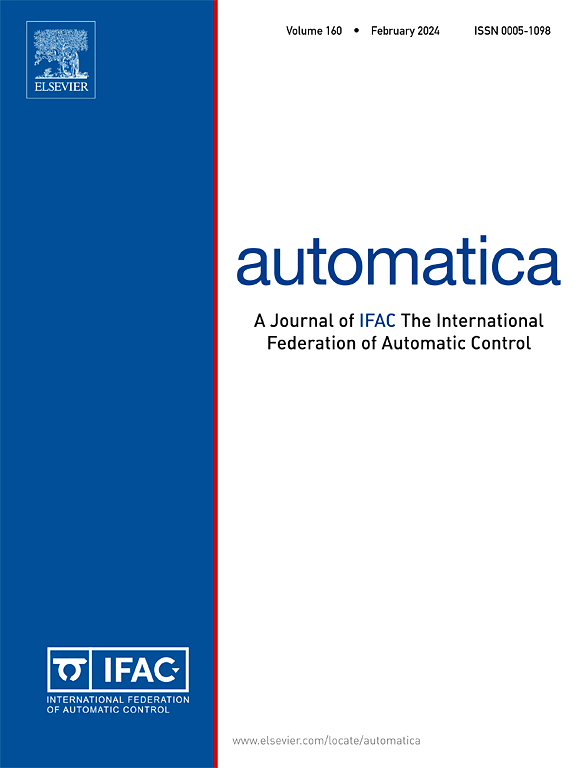虚假数据注入攻击下网络物理系统的远程安全融合评估
IF 4.8
2区 计算机科学
Q1 AUTOMATION & CONTROL SYSTEMS
引用次数: 0
摘要
本文讨论了网络物理系统遭受恶意攻击时的安全融合估计问题。配备计算模块的智能传感器通过无线通信通道将本地后验估计传输到远程融合中心。传输过程容易受到虚假数据注入攻击。因此,为了提高估计器的弹性,在攻击信息不可用或部分可用的情况下,协同设计了保护和融合策略。值得注意的是,与使用智能传感器的创新信息不同,一组辅助数据与本地估计一起传输,用于远程端的攻击检测。然后,根据检测信号,保护器在每个瞬间决定是否直接丢弃接收到的估计,以及是否采取补偿措施。进一步,分析推导了不同情况下融合估计协方差的演化和收敛结果,并从理论上推导了收敛结果的比较。此外,现有的融合估计成果大多是利用局部最优卡尔曼滤波得出的,这意味着融合估计可能不是全局最优的,需要进一步改进。因此,在分析卡尔曼滤波器的稳态和误差协方差收敛性的基础上,提出了一种更新局部滤波器增益的迭代方法,以进一步减小融合估计误差。最后给出了在雷达跟踪和微电网中的实际应用实例来验证推导结果。本文章由计算机程序翻译,如有差异,请以英文原文为准。
Remote secure fusion estimation of cyber–physical systems under false data injection attacks
This paper discusses the secure fusion estimation issue for cyber–physical systems subject to malicious attacks. Smart sensors equipped with computing modules transmit local posteriori estimations to remote fusion center through wireless communication channels. The transmission process is considered to be vulnerable to false data injection attacks. Therefore, to enhance the resilient of the estimator, protection and fusion strategies are collaboratively designed under cases where the attack information is unavailable or partially available. Noteworthy, instead of using innovation information from smart sensors, a set of auxiliary data transmitted along with local estimations is utilized for attack detection at the remote side. Then, according to the detection signal, the protector at each instant decides whether to drop the received estimations directly, and whether to take compensation measures. Further, the evolution and convergence results of fusion estimation covariance under different cases are analytically derived, and the comparisons of the convergence results are also theoretically deduced. Besides, most of existing achievements on fusion estimation are derived by utilizing local optimal Kalman filter, which implies that the fusion estimation may not be globally optimal and can be further improved. Thus, based on the analysis of steady-state and convergence of error covariance for Kalman filter, a novel iterative procedure for updating the local filter gains is proposed as the first attempt to further reduce fusion estimation error. Several examples including practical application in radar tracking and microgrids are finally provided to verify the derived results.
求助全文
通过发布文献求助,成功后即可免费获取论文全文。
去求助
来源期刊

Automatica
工程技术-工程:电子与电气
CiteScore
10.70
自引率
7.80%
发文量
617
审稿时长
5 months
期刊介绍:
Automatica is a leading archival publication in the field of systems and control. The field encompasses today a broad set of areas and topics, and is thriving not only within itself but also in terms of its impact on other fields, such as communications, computers, biology, energy and economics. Since its inception in 1963, Automatica has kept abreast with the evolution of the field over the years, and has emerged as a leading publication driving the trends in the field.
After being founded in 1963, Automatica became a journal of the International Federation of Automatic Control (IFAC) in 1969. It features a characteristic blend of theoretical and applied papers of archival, lasting value, reporting cutting edge research results by authors across the globe. It features articles in distinct categories, including regular, brief and survey papers, technical communiqués, correspondence items, as well as reviews on published books of interest to the readership. It occasionally publishes special issues on emerging new topics or established mature topics of interest to a broad audience.
Automatica solicits original high-quality contributions in all the categories listed above, and in all areas of systems and control interpreted in a broad sense and evolving constantly. They may be submitted directly to a subject editor or to the Editor-in-Chief if not sure about the subject area. Editorial procedures in place assure careful, fair, and prompt handling of all submitted articles. Accepted papers appear in the journal in the shortest time feasible given production time constraints.
 求助内容:
求助内容: 应助结果提醒方式:
应助结果提醒方式:


